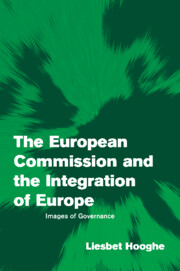Book contents
- Frontmatter
- Contents
- List of figures
- List of tables
- Preface
- Prologue
- 1 Preference formation in the European Commission
- 2 Men (and women) at Europe's helm
- 3 Images of Europe
- 4 Beyond supranational interest
- 5 Capitalism against capitalism
- 6 Principal or agent
- 7 Accommodating national diversity
- 8 Conclusion
- Appendix I Statistics
- Appendix II Description of independent variables
- Appendix III Survey material
- References
- Index
4 - Beyond supranational interest
Published online by Cambridge University Press: 22 September 2009
- Frontmatter
- Contents
- List of figures
- List of tables
- Preface
- Prologue
- 1 Preference formation in the European Commission
- 2 Men (and women) at Europe's helm
- 3 Images of Europe
- 4 Beyond supranational interest
- 5 Capitalism against capitalism
- 6 Principal or agent
- 7 Accommodating national diversity
- 8 Conclusion
- Appendix I Statistics
- Appendix II Description of independent variables
- Appendix III Survey material
- References
- Index
Summary
In search of supranationalists
Interviewing in the Commission's most powerful directorates-general is carefully regulated, perhaps because the prey is much in demand, highly prized, and occasionally somewhat threatening to the hunter. Visitors to the directorate-general (DG) for competition policy are chaperoned from the security guards' reception desk to the interviewee's office and back, to prevent them from roaming through secret competition files. Security guards also man access to the DG for agriculture – as they do for virtually all Commission buildings. They collect passports and information on profession and address, and they phone the contact person. The guards in the DG for agriculture allow one to make the journey up to floor five, seven or eight all by oneself. Yet the headquarters of this DG are intimidating: the floor plan is labyrinthine, the silent windowless corridors with closed doors are endless, and the building's lopsided structure with multiple exits is confusing as it plunges from the hilltop on Wetstraat onto Joseph Ⅱ Straat approximately 70 feet lower. Maybe because of this architecture – incomprehensible to the outsider – the ethos of discipline, power, and confidence is all the more palpable.
A visitor may be forgiven for perceiving these fortress-like features as telling symbols of the Commission's preference for supranationalism. Reality is more complicated. Top officials in these strongholds vary appreciably in the degree to which they support a supranational or an intergovernmental Union.
- Type
- Chapter
- Information
- The European Commission and the Integration of EuropeImages of Governance, pp. 93 - 117Publisher: Cambridge University PressPrint publication year: 2002

